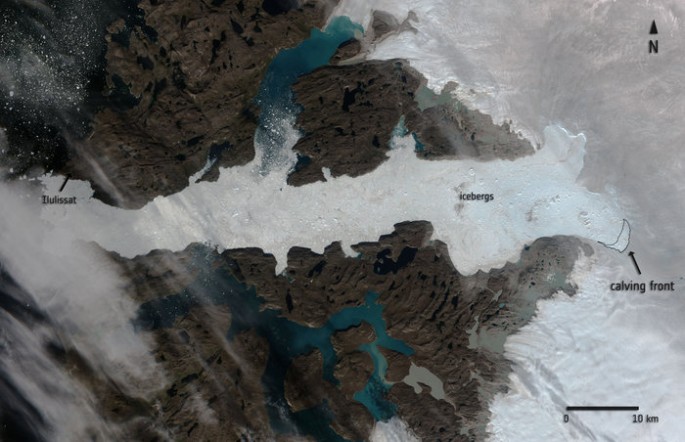The world's fastest moving glacier apparently just lost a massive chunk of ice that measures almost 5 square miles, in the span of two days. Data from satellite images revealed to scientists that this event is one of the most significant calving events currently on record.
This huge ice formation called the Jakobshavn glacier located in Greenland was captured by the European Space Agency's Sentinel-1A and Sentinel-2A weather satellites that obtained radar images from July 27 to August 19 this year.
The images show that the massive glacier is now moving westward where its front region retreated suddenly as a chunk of ice collapsed off its front, that occurred between August 14 and August 16.
Scientists from ESA now estimate that the ice that fell of is about 4,600 feet thick which means that the ice that was lost possessed a volume of around 17.5 cubic kilometers that can compared to the island of Manhattan with a layer of ice that is 1,000 feet deep.
The Sentinel-1A satellite captured radar images of the Jakobshavn glacier in the western region of Greenland before and after this huge calving event between this August 14 and August 16, 2015. This composite image is comprised of various Sentinel-1A images taken from July 27, August 13 and August 19, 2015. The calving front position and other significant features reveal movement based on the image.
This is not the first time that a massive calving event occurred before such as the one in July 2010 where the area was only half of the ice lost compared to this month's event.
As the world's second largest ice structure, Greenland is now experiencing ice sheet melting that have already contributed to 40 percent of the present rising sea levels. The Jakobshavn glacier now drains 6.5 percent of the entire Greenland ice sheet where it also produces one tenth of its icebergs which is estimated to be 35 million tons of ice that are calved every year.
This study also revealed that during the first part of the millennium, glaciers are now melting at the fastest rate ever compared to any event from the last 165 years, in recorded history.
This study is published in the Journal of Glaciology by the World Glacier Monitoring Service.



























